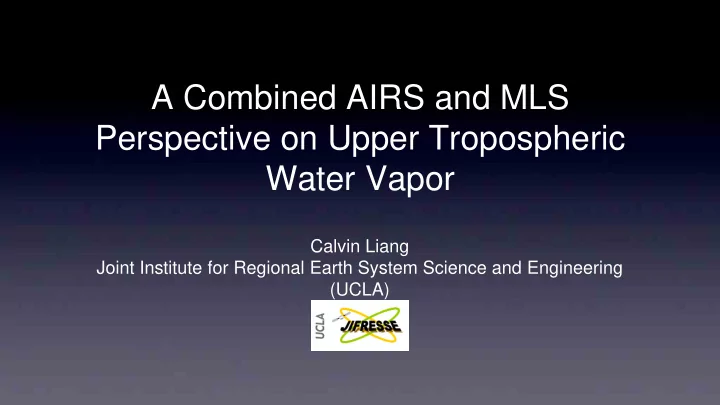

A Combined AIRS and MLS Perspective on Upper Tropospheric Water Vapor Calvin Liang Joint Institute for Regional Earth System Science and Engineering (UCLA)
Motivation • Better characterize upper tropospheric humidity (UTH) in relation to clouds; i.e. quantify moistening and drying processes. We need a dataset that characterizes water vapor at high altitudes. • AIRS loses sensitivity at high altitudes; the addition of MLS provides more insight into UTH at these levels. • Past work shows the addition of MLS primarily increases the amount of supersaturation seen in UT relative humidity distributions.
The Dataset • AIRS V5 Support Product; includes water vapor averaging kernels • MLS v2.22 Data with offline produced averaging kernels • Clearsky data only (for now). • Focus: -40 ≤ Latitude ≤ 40.
Methods of Splicing (1) Use a H 2 O concentration cutoff (e.g. cutting off AIRS at 15 ppmv) then splice MLS everywhere above, or (2) Combine AIRS & MLS H 2 O information with their averaging kernels to create a weighted mean profile. Use MLS error bar as a “zeroth” order metric for “goodness” of the joined profiles.
Sample Profile “Inside” “Outside”
Joint Histogram (Full Kernel) The percentage of “outside” points is evenly distributed over ocean and land
Distribution of “outside” points But “outside” points are more concentrated over land especially at higher altitudes.
Information Distribution (Where) • AIRS is getting most of its information from the ~270 hPa or ~170 hPa level. • Upper levels are getting “information” from lower parts of the atmosphere. • Surface conditions impacts AIRS retrievals
Information Distribution (cont) 83hPa Level 100hPa Level 121hPa Level 147hPa Level • 90S-40S, 40N-90N • At dryer latitudes, AIRS retrievals 178hPa Level 215hPa Level 261hPa Level pulls information from even lower parts of the atmosphere.
Verticality Distribution (How Much) • At lower levels information content (verticality) is high • At higher levels, verticality decreases but is not negligible; affects the weighted mean profiles
FWHM Weighting • Weight H 2 O profiles by portion of verticality only around retrieval level. • We define this layer to be approximately the MLS full-width-half- maximum, a standard way to qualitatively define instrument resolution.
Joint Histogram (FWHM) Number of “outside” points decreases when using the verticality information over the FWHM layer.
Distribution of “outside” points “Outside” points still concentrated over land, but at higher levels number decreases significantly
Information Distribution Verticality distribution shifts to much smaller values especially at upper levels.
Conclusion • AIRS and MLS have similar information content between ~215 hPa and 270 hPa. Above that AIRS starts to lose sensitivity at the retrieval layer. • Vertical information distribution (location and amount) indicates that AIRS is grabbing retrieval information from levels well below the retrieval layer, especially for lower pressure values; this especially occurs at high latitudes. • Limiting the verticality to the FWHM portion of the averaging kernels (limiting the information content to a region around the retrieval layer) produces more profiles that fall within the “zeroth” order MLS error test. • Next step will be to identify what the impact of joining the profiles is on relative humidity, especially important for 215 hPa < P < 270 hPa where AIRS-MLS has large regions with similar information content (averaging kernels).
Verticality Distribution (How Much)
Joint Histogram (Ocean)
Joint Histogram (Land)
Recommend
More recommend